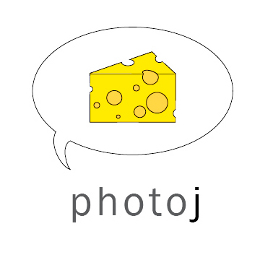I went in with admittedly low expectations. I thought staying overnight at Paradise Inn meant a tiny, cramped room at Four Seasons prices, with a gross floral poly bedspread that you don’t really want to touch, much less cover your body with. The photos on the reservation site (they’ve since been updated) showed the rooms pre-remodel, and I was a little leery.

The annex at
Mount Rainier National Park’s Paradise Inn, originally built in 1921, re-opened in May after a $25 million, 19 month renovation. A big chunk of that money went to boring but necessary structural stuff (electrical and plumbing updates, seismic bracings, energy efficient upgrades, etc.) but what visitors will notice is the dramatic transformation of its 79 guest rooms.

Beautiful.
What’s old is new again. During the remodel, workers removed the ’70s-era wood paneling and dropped ceilings, revealing original crown molding and opening the rooms up. Big windows let in natural light and a view of pine trees and snowy peaks. Crisp linens and a coat of new paint refreshed the rooms, while framed historical photos provide a look at the inn’s past. Soundproofing was added in between the rooms during the renovation. We could still hear our neighbors’ muffled sounds, but we were so pooped from a day of tromping around we zonked out anyway.

Can you have a luxurious mountain adventure? There’s no wi-fi, no TV, no minifridge, no microwave, no elevator and definitely no swimming pool. (Well, that’s not entirely true, there’s free wi-fi at the Henry M. Jackson Visitor Center.) There is a hairdryer and rustic-chic furniture. You’ll get an actual key at check-in. To make a call, use the payphones in the lobby.

Bring board games to play in the main lodge in the evening. It’s a humongous room flanked by two stone fireplaces. A pianist played for hours on the only piano I’ve ever seen done in woodland-cottage style. On the mezzanine, there’s complimentary tea and cookies at 3:30 p.m., and a selection of paperback bodice rippers for borrowing or for keeps.

Food-wise, you’re a captive audience unless you pack in your own provisions. (We supplemented with a cooler-full of
the best of Trader Joe’s.) Expect so-so fare at sky-high prices, which adds up fast when you’re feeding a family. Go to the visitor center for pizza and hot dogs, the Tatoosh Café at the Inn for sandwiches, or splurge on a meal at the Inn’s dining room (think $25 hamburgers). The kid’s menu, for ages 10 and under, is a reasonable $7.50, although honestly, the $2.50 Egg McMuffin we grabbed on the drive up was way tastier. I nearly packed my rice cooker and felt completely validated when I saw another family picnicking around their rice cooker. My kind of mountain explorers.
 Rainier’s history
Rainier’s history
For the uninitiated, you have to know that Paradise is an incredibly accessible wilderness experience. If your closet looks like REI threw up there, Paradise Inn is not for you. If you’re sightseeing with older grandparents, pregnant mamas and willful toddlers, Paradise offers the right dose of adventure. There’s a swank visitor center next to that newly remodeled inn. Starting from the parking lot are several paved trails, varying in difficulty from super easy to strenuous.
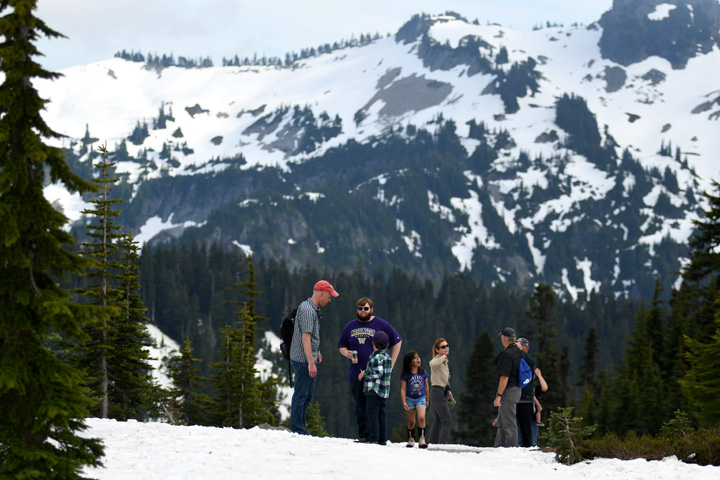
Since the 1890s, Paradise has served as a base camp for exploring Mount Rainier. Back then, visitors arrived by stagecoach to a tent city called “Camp of the Clouds.” The main lodge opened in 1917; the original building was assembled without using a single nail. Paradise was so popular, more amenities were added over the years: a rope tow for skiers in the 1930s, 275 housekeeping cabins and a 9-hole golf course during the Depression, and swaths of car camping in the 1960s. All that stuff is gone now, and a planned second wing of the annex was never built. The priority now is to restore the wildflower meadows.

This volcano is a lot of things to different people. For the Native Americans, Mount Rainier was a God. For mountaineers, it’s a climbing obstacle course. For tourists and locals, it’s the most iconic landmark in Pacific Northwest. Walking through the parking lot read a lot like a roll call of the United States map. My kids knocked off half the states on their license plate quest at the Paradise lot alone.

In the Jackson Visitor Center, there’s a café, a gift shop (of course) and a really nice interactive exhibit about the mountain’s history, geology and culture. The rangers are gracious and helpful. Stop at the info desk to pick up a kids’ activity book. Bring it back when you’re done and get sworn in as a Junior Ranger, complete with an official badge and certificate.
 Family-friendly trails
Family-friendly trails
We stuck to the trails at Paradise earmarked for families with strollers and wheelchairs:
Myrtle Falls (1 mile) and the
Nisqually Vista trail (1.2 miles). Easy peasy, right? Except remember Snowmageddon? Apparently it hit Rainier hard too, and the trails were still covered with snow in
June. The park ranger instructed us to walk across the snow, not around it, to avoid trampling wildflowers. Our sneakers slipped on the steep snow fields, and I saw even more unprepared visitors in saris and flip flops.

That much snow was unexpected and very slick. But when I asked my 8-year-old what he liked best about Mount Rainier, and he said, “The snow. And dinner at the restaurant.” (We don’t get out much.)

July and August are the prime months to visit Paradise; that’s when the wildflower meadows reach their full glory. But the height of tourist season also means you’ll be lucky to snag a spot in the parking lot. If you visit in June or September, bring snow gear and lots of layers just in case.

Staying overnight allowed us a better window for mountain adventures. The previous year, we’d attempted a day trip, but 6½ hours in the car later, we never even made it more than 400 yards from the visitor center.

My kids are novice hikers, and I didn’t quite trust them to not tumble down the drop-offs at the side of the paved path. Looong way down. We did make it as far as the Nisqually Vista trail viewpoint, where we saw tiny specks climbing toward Camp Muir. “They’re almost to the sky,” my 4-year-old observed. Even more thrilling were the deer we spotted, standing less than 10 feet away in the woods.

.
The following morning we had better luck hiking at lower elevations.
Narada Falls is a mile or so south of Paradise, and the trail from the parking lot to the viewpoint is a mere 0.1 miles. We made it to the base of the waterfall with minimal whining and even spotted a rainbow in the mist. The
Grove of the Patriarchs trail (1.3 miles) at Ohanapecosh also had a big pay-off at the end: a cluster of majestic 1,000-year-old trees.
 If you go
Park entry fee:
If you go
Park entry fee: $30 per vehicle.
National Park free days for 2019 are Aug. 25, Sept. 28 and Nov. 11. If you have a fourth grader (now rising fifth grader), you can also get an
Every Kid in a Park pass for free access through Aug. 31.
 Paradise Inn:
Paradise Inn: Rooms in main lodge have shared bathrooms; all the rooms in the annex ($205 to $332 plus tax) have private baths. You’ll get a closet with your own toilet (money well spent!) and a shower the size of a phone booth.
The rooms are in various configurations of twins, doubles and queens.
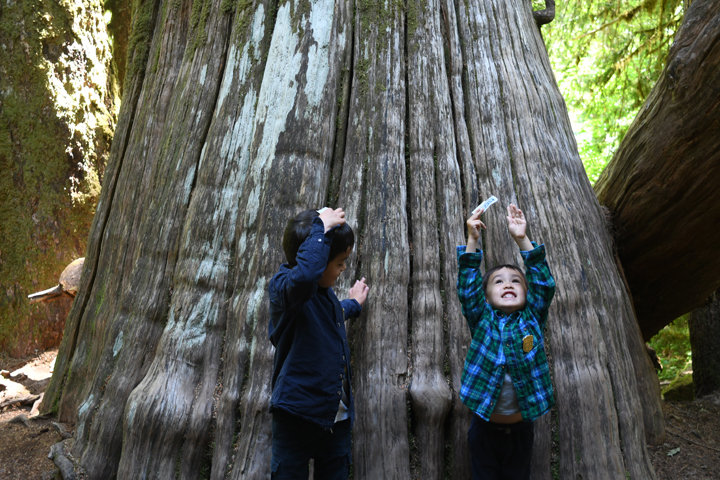
The Inn is open through Sept. 30. Rooms can be reserved a year in advance – book now for
next summer. July and August, which have a 2-night minimum, are mostly full, though you have a better chance in September.
 Summer day trip:
Summer day trip: Visit on a weekday, if possible. If you can only go on a weekend, plan to arrive at Paradise by 10 a.m. The parking lots fill up fast on clear summer days. Note that there are no gas stations inside the park.
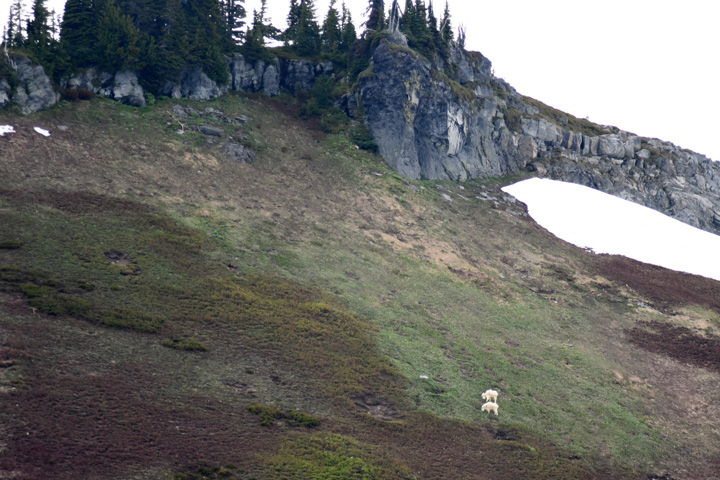 Nearby attractions: Northwest Trek Wildlife Park
Nearby attractions: Northwest Trek Wildlife Park and the
Mt Rainier Railroad & Logging Museum are both located near the Nisqually entrance. They’re great for the whole family and well worth the admission. If you can swing an extra day, we recommend adding them onto your Mount Rainier itinerary.
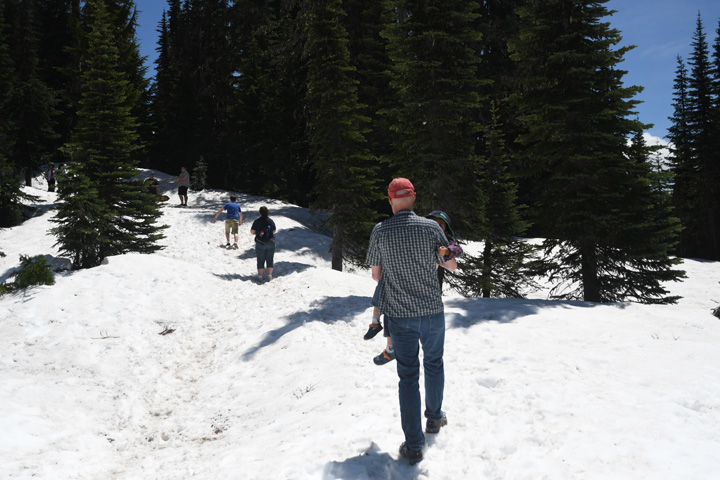
 The annex at Mount Rainier National Park’s Paradise Inn, originally built in 1921, re-opened in May after a $25 million, 19 month renovation. A big chunk of that money went to boring but necessary structural stuff (electrical and plumbing updates, seismic bracings, energy efficient upgrades, etc.) but what visitors will notice is the dramatic transformation of its 79 guest rooms.
The annex at Mount Rainier National Park’s Paradise Inn, originally built in 1921, re-opened in May after a $25 million, 19 month renovation. A big chunk of that money went to boring but necessary structural stuff (electrical and plumbing updates, seismic bracings, energy efficient upgrades, etc.) but what visitors will notice is the dramatic transformation of its 79 guest rooms.
 Beautiful.
What’s old is new again. During the remodel, workers removed the ’70s-era wood paneling and dropped ceilings, revealing original crown molding and opening the rooms up. Big windows let in natural light and a view of pine trees and snowy peaks. Crisp linens and a coat of new paint refreshed the rooms, while framed historical photos provide a look at the inn’s past. Soundproofing was added in between the rooms during the renovation. We could still hear our neighbors’ muffled sounds, but we were so pooped from a day of tromping around we zonked out anyway.
Beautiful.
What’s old is new again. During the remodel, workers removed the ’70s-era wood paneling and dropped ceilings, revealing original crown molding and opening the rooms up. Big windows let in natural light and a view of pine trees and snowy peaks. Crisp linens and a coat of new paint refreshed the rooms, while framed historical photos provide a look at the inn’s past. Soundproofing was added in between the rooms during the renovation. We could still hear our neighbors’ muffled sounds, but we were so pooped from a day of tromping around we zonked out anyway.
 Can you have a luxurious mountain adventure? There’s no wi-fi, no TV, no minifridge, no microwave, no elevator and definitely no swimming pool. (Well, that’s not entirely true, there’s free wi-fi at the Henry M. Jackson Visitor Center.) There is a hairdryer and rustic-chic furniture. You’ll get an actual key at check-in. To make a call, use the payphones in the lobby.
Can you have a luxurious mountain adventure? There’s no wi-fi, no TV, no minifridge, no microwave, no elevator and definitely no swimming pool. (Well, that’s not entirely true, there’s free wi-fi at the Henry M. Jackson Visitor Center.) There is a hairdryer and rustic-chic furniture. You’ll get an actual key at check-in. To make a call, use the payphones in the lobby.
 Bring board games to play in the main lodge in the evening. It’s a humongous room flanked by two stone fireplaces. A pianist played for hours on the only piano I’ve ever seen done in woodland-cottage style. On the mezzanine, there’s complimentary tea and cookies at 3:30 p.m., and a selection of paperback bodice rippers for borrowing or for keeps.
Bring board games to play in the main lodge in the evening. It’s a humongous room flanked by two stone fireplaces. A pianist played for hours on the only piano I’ve ever seen done in woodland-cottage style. On the mezzanine, there’s complimentary tea and cookies at 3:30 p.m., and a selection of paperback bodice rippers for borrowing or for keeps.
 Food-wise, you’re a captive audience unless you pack in your own provisions. (We supplemented with a cooler-full of the best of Trader Joe’s.) Expect so-so fare at sky-high prices, which adds up fast when you’re feeding a family. Go to the visitor center for pizza and hot dogs, the Tatoosh Café at the Inn for sandwiches, or splurge on a meal at the Inn’s dining room (think $25 hamburgers). The kid’s menu, for ages 10 and under, is a reasonable $7.50, although honestly, the $2.50 Egg McMuffin we grabbed on the drive up was way tastier. I nearly packed my rice cooker and felt completely validated when I saw another family picnicking around their rice cooker. My kind of mountain explorers.
Food-wise, you’re a captive audience unless you pack in your own provisions. (We supplemented with a cooler-full of the best of Trader Joe’s.) Expect so-so fare at sky-high prices, which adds up fast when you’re feeding a family. Go to the visitor center for pizza and hot dogs, the Tatoosh Café at the Inn for sandwiches, or splurge on a meal at the Inn’s dining room (think $25 hamburgers). The kid’s menu, for ages 10 and under, is a reasonable $7.50, although honestly, the $2.50 Egg McMuffin we grabbed on the drive up was way tastier. I nearly packed my rice cooker and felt completely validated when I saw another family picnicking around their rice cooker. My kind of mountain explorers.
 Rainier’s history
For the uninitiated, you have to know that Paradise is an incredibly accessible wilderness experience. If your closet looks like REI threw up there, Paradise Inn is not for you. If you’re sightseeing with older grandparents, pregnant mamas and willful toddlers, Paradise offers the right dose of adventure. There’s a swank visitor center next to that newly remodeled inn. Starting from the parking lot are several paved trails, varying in difficulty from super easy to strenuous.
Rainier’s history
For the uninitiated, you have to know that Paradise is an incredibly accessible wilderness experience. If your closet looks like REI threw up there, Paradise Inn is not for you. If you’re sightseeing with older grandparents, pregnant mamas and willful toddlers, Paradise offers the right dose of adventure. There’s a swank visitor center next to that newly remodeled inn. Starting from the parking lot are several paved trails, varying in difficulty from super easy to strenuous.
 Since the 1890s, Paradise has served as a base camp for exploring Mount Rainier. Back then, visitors arrived by stagecoach to a tent city called “Camp of the Clouds.” The main lodge opened in 1917; the original building was assembled without using a single nail. Paradise was so popular, more amenities were added over the years: a rope tow for skiers in the 1930s, 275 housekeeping cabins and a 9-hole golf course during the Depression, and swaths of car camping in the 1960s. All that stuff is gone now, and a planned second wing of the annex was never built. The priority now is to restore the wildflower meadows.
Since the 1890s, Paradise has served as a base camp for exploring Mount Rainier. Back then, visitors arrived by stagecoach to a tent city called “Camp of the Clouds.” The main lodge opened in 1917; the original building was assembled without using a single nail. Paradise was so popular, more amenities were added over the years: a rope tow for skiers in the 1930s, 275 housekeeping cabins and a 9-hole golf course during the Depression, and swaths of car camping in the 1960s. All that stuff is gone now, and a planned second wing of the annex was never built. The priority now is to restore the wildflower meadows.
 This volcano is a lot of things to different people. For the Native Americans, Mount Rainier was a God. For mountaineers, it’s a climbing obstacle course. For tourists and locals, it’s the most iconic landmark in Pacific Northwest. Walking through the parking lot read a lot like a roll call of the United States map. My kids knocked off half the states on their license plate quest at the Paradise lot alone.
This volcano is a lot of things to different people. For the Native Americans, Mount Rainier was a God. For mountaineers, it’s a climbing obstacle course. For tourists and locals, it’s the most iconic landmark in Pacific Northwest. Walking through the parking lot read a lot like a roll call of the United States map. My kids knocked off half the states on their license plate quest at the Paradise lot alone.
 In the Jackson Visitor Center, there’s a café, a gift shop (of course) and a really nice interactive exhibit about the mountain’s history, geology and culture. The rangers are gracious and helpful. Stop at the info desk to pick up a kids’ activity book. Bring it back when you’re done and get sworn in as a Junior Ranger, complete with an official badge and certificate.
In the Jackson Visitor Center, there’s a café, a gift shop (of course) and a really nice interactive exhibit about the mountain’s history, geology and culture. The rangers are gracious and helpful. Stop at the info desk to pick up a kids’ activity book. Bring it back when you’re done and get sworn in as a Junior Ranger, complete with an official badge and certificate.
 Family-friendly trails
We stuck to the trails at Paradise earmarked for families with strollers and wheelchairs: Myrtle Falls (1 mile) and the Nisqually Vista trail (1.2 miles). Easy peasy, right? Except remember Snowmageddon? Apparently it hit Rainier hard too, and the trails were still covered with snow in June. The park ranger instructed us to walk across the snow, not around it, to avoid trampling wildflowers. Our sneakers slipped on the steep snow fields, and I saw even more unprepared visitors in saris and flip flops.
Family-friendly trails
We stuck to the trails at Paradise earmarked for families with strollers and wheelchairs: Myrtle Falls (1 mile) and the Nisqually Vista trail (1.2 miles). Easy peasy, right? Except remember Snowmageddon? Apparently it hit Rainier hard too, and the trails were still covered with snow in June. The park ranger instructed us to walk across the snow, not around it, to avoid trampling wildflowers. Our sneakers slipped on the steep snow fields, and I saw even more unprepared visitors in saris and flip flops.
 That much snow was unexpected and very slick. But when I asked my 8-year-old what he liked best about Mount Rainier, and he said, “The snow. And dinner at the restaurant.” (We don’t get out much.)
That much snow was unexpected and very slick. But when I asked my 8-year-old what he liked best about Mount Rainier, and he said, “The snow. And dinner at the restaurant.” (We don’t get out much.)
 July and August are the prime months to visit Paradise; that’s when the wildflower meadows reach their full glory. But the height of tourist season also means you’ll be lucky to snag a spot in the parking lot. If you visit in June or September, bring snow gear and lots of layers just in case.
July and August are the prime months to visit Paradise; that’s when the wildflower meadows reach their full glory. But the height of tourist season also means you’ll be lucky to snag a spot in the parking lot. If you visit in June or September, bring snow gear and lots of layers just in case.
 Staying overnight allowed us a better window for mountain adventures. The previous year, we’d attempted a day trip, but 6½ hours in the car later, we never even made it more than 400 yards from the visitor center.
Staying overnight allowed us a better window for mountain adventures. The previous year, we’d attempted a day trip, but 6½ hours in the car later, we never even made it more than 400 yards from the visitor center.
 My kids are novice hikers, and I didn’t quite trust them to not tumble down the drop-offs at the side of the paved path. Looong way down. We did make it as far as the Nisqually Vista trail viewpoint, where we saw tiny specks climbing toward Camp Muir. “They’re almost to the sky,” my 4-year-old observed. Even more thrilling were the deer we spotted, standing less than 10 feet away in the woods.
My kids are novice hikers, and I didn’t quite trust them to not tumble down the drop-offs at the side of the paved path. Looong way down. We did make it as far as the Nisqually Vista trail viewpoint, where we saw tiny specks climbing toward Camp Muir. “They’re almost to the sky,” my 4-year-old observed. Even more thrilling were the deer we spotted, standing less than 10 feet away in the woods.
 .
The following morning we had better luck hiking at lower elevations. Narada Falls is a mile or so south of Paradise, and the trail from the parking lot to the viewpoint is a mere 0.1 miles. We made it to the base of the waterfall with minimal whining and even spotted a rainbow in the mist. The Grove of the Patriarchs trail (1.3 miles) at Ohanapecosh also had a big pay-off at the end: a cluster of majestic 1,000-year-old trees.
.
The following morning we had better luck hiking at lower elevations. Narada Falls is a mile or so south of Paradise, and the trail from the parking lot to the viewpoint is a mere 0.1 miles. We made it to the base of the waterfall with minimal whining and even spotted a rainbow in the mist. The Grove of the Patriarchs trail (1.3 miles) at Ohanapecosh also had a big pay-off at the end: a cluster of majestic 1,000-year-old trees.
 If you go
Park entry fee: $30 per vehicle. National Park free days for 2019 are Aug. 25, Sept. 28 and Nov. 11. If you have a fourth grader (now rising fifth grader), you can also get an Every Kid in a Park pass for free access through Aug. 31.
If you go
Park entry fee: $30 per vehicle. National Park free days for 2019 are Aug. 25, Sept. 28 and Nov. 11. If you have a fourth grader (now rising fifth grader), you can also get an Every Kid in a Park pass for free access through Aug. 31.
 Paradise Inn: Rooms in main lodge have shared bathrooms; all the rooms in the annex ($205 to $332 plus tax) have private baths. You’ll get a closet with your own toilet (money well spent!) and a shower the size of a phone booth. The rooms are in various configurations of twins, doubles and queens.
Paradise Inn: Rooms in main lodge have shared bathrooms; all the rooms in the annex ($205 to $332 plus tax) have private baths. You’ll get a closet with your own toilet (money well spent!) and a shower the size of a phone booth. The rooms are in various configurations of twins, doubles and queens.
 The Inn is open through Sept. 30. Rooms can be reserved a year in advance – book now for next summer. July and August, which have a 2-night minimum, are mostly full, though you have a better chance in September.
The Inn is open through Sept. 30. Rooms can be reserved a year in advance – book now for next summer. July and August, which have a 2-night minimum, are mostly full, though you have a better chance in September.
 Summer day trip: Visit on a weekday, if possible. If you can only go on a weekend, plan to arrive at Paradise by 10 a.m. The parking lots fill up fast on clear summer days. Note that there are no gas stations inside the park.
Summer day trip: Visit on a weekday, if possible. If you can only go on a weekend, plan to arrive at Paradise by 10 a.m. The parking lots fill up fast on clear summer days. Note that there are no gas stations inside the park.
 Nearby attractions: Northwest Trek Wildlife Park and the Mt Rainier Railroad & Logging Museum are both located near the Nisqually entrance. They’re great for the whole family and well worth the admission. If you can swing an extra day, we recommend adding them onto your Mount Rainier itinerary.
Nearby attractions: Northwest Trek Wildlife Park and the Mt Rainier Railroad & Logging Museum are both located near the Nisqually entrance. They’re great for the whole family and well worth the admission. If you can swing an extra day, we recommend adding them onto your Mount Rainier itinerary.

